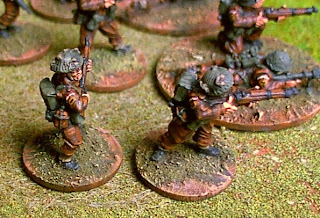British Armoured Platoon - (29th Armoured Brigade, 11th Armoured Division.)
Introduction.
I've been collecting 28mm figures for a World War 2 bash sometime in the future, starting with a British armoured platoon based on units of the 11th Armoured Division 1944 & 1945.
After selecting
'Rules of Engagement' (
RoE) as my chosen ruleset I set about looking for miniatures which I'd like to paint settling on Artizan Designs WW2 range of 28mm figures representing the 8th Battalion Rifles the 'infantry' part of 29th Armoured Brigade
The Army list I have used is the new free to download 'British Motor Platoon 1944' available from:
http://www.greatescapegames.co.uk/rules-of-engagement/downloads/orders-of-battle/late-war
The Platoon will consist of:
1 Infantry Platoon HQ section
the section is mounted in a M3A1 armoured car
3 Infantry sections (squads) (maximum of 2 PIAT and added as additional equipment)
each section is mounted in a M5 halftrack
Support Options:
1 Company support section sustained fire Heavy Machine Gun (2nd (Independent) Machine Gun Company of the Royal Northumberland Fusiliers)
the section is mounted in a universal carrier
1 Company support section with 3 inch mortar
the section is mounted in a universal carrier
1 Divisional support 1x tank (Sherman Vc for a 1944 game or Comet A34 for a 1945 game).
using
RoE rules this gives me a Combat Effectiveness (CE) of 24
RoE Divisional support: 1x Comet(A34) Tank, as I can only use this tank from 1945 I'll try to buy a Sherman markV or Sherman Vc 'firefly' for a mid to late 1944 game.
The chosen model was the A-34 'Comet' from the Die Waffenkammer range available through JTFM. I found that the manufacturer had fitted the tracks to the hull perfectly, also little details such as the headlights and headlight guards were part of the resin casting on the hull which I found to be a big bonus. This has been the best produced 1/56th scale model I have bought to date 10/10 for quality.
 |
| A-34 Comet 2nd Fife & Forfar Regiment 11th Armoured Division 1945. |
Apparently the naming convention for this regiment when equipped with the comet tank were the names of saints for the Regimental Headquaters Squadron, alas I acquired a limited transfer sheet of names and chose
venus for this model.
The only other names I can find for this regiment are:
BROWN JACK squadron & serial unknown.
WHY WORRY? squadron unknown, serial T335346
The regiment code is 53 white lettering on red square, divisional badge black bull on yellow rectangle.
 |
| markings front view |
 |
| markings rear view |
The squadron markings are in blue, diamond for HQ squadron, triangle for the A squadron, square for B squadron and circle for C squadron. I've added a bridging disc denoting 40 ton load, the comet is actual weight is somewhat closer to approx 33 tons.
The tank commander is from Warlord Games Bolt action range.
Extra details were added such as the coiled searchlight cable, aerial and padding on the inside of the open hatch.
The Comet tank had a 77mmL50 gun capable of firing APCBC, HE and APDS, the projectile was identical to the 17pdr on the Sherman Firefly but the cartridge was different with lower muzzle velocity and thus less penetration.
The Armoured infantry representing the 8th Battalion Rifle Brigade will be next.
to be continued....












.JPG)
.JPG)
.JPG)




.JPG)


.JPG)
.JPG)
.JPG)
.JPG)
.JPG)
.JPG)

.JPG)

.JPG)

.JPG)
.JPG)

.jpg)
.JPG)
.JPG)






.JPG)


.JPG)
.JPG)
.JPG)
.JPG)